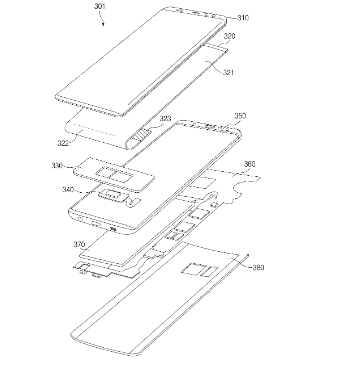The Samsung Galaxy S10 has long been rumored to include an in-display fingerprint sensor, and now a new Samsung patent almost confirms this feature, if not for the S10, perhaps for another upcoming handset.
What the new Samsung patent reveals
This new Samsung patent was filed with the (World Intellectual Property Organization (WIPO) in April and published just yesterday. The patent is titled “Biometric sensor and device including the same,” and it details the working of the optical in-display fingerprint scanner.
This is not the first time we have seen patent like this, but it is the most advanced implementation of the scanner to have come forward so far. Samsung’s patent addresses an issue which causes the external elements to make the scanner inefficient over time.
The new Samsung patent details a system in which the fingerprint sensor is fixed to an opening on a printed circuit board. This helps maintain a safe distance between the sensor and the display, a crucial requirement for proper functioning.
Now that we know Samsung is working on advanced fingerprint sensor tech, it could mean that it will be included in the upcoming Galaxy S10.
One of the images in the patent application details an “optical” method with optical filters and layers. This suggests the technology is best suited for a premium device like the Galaxy S10. Further, an image shows a device similar to the Galaxy S9 with an Infinity Display design and curved edges.
Since the S9 is already out and we know it does not have an in-display fingerprint sensor, there are good chances that the Korean firm’s next flagship will feature the patented tech. If this image is of the Galaxy S10, then it may come with a display that folds underneath to connect with the logic board. Apple used a similar design for the iPhone X to eliminate the bottom bezel, and Samsung certainly knows the design well because it makes the iPhone X/XS displays for Apple.
Ultrasonic fingerprint scanner or optical in-display fingerprint sensor?
So far, it has been speculated that the Korean firm will use Qualcomm’s ultrasonic fingerprint scanner for the Galaxy S10. However, the new Samsung patent suggests the company could develop its own in-display sensor.
Lately, it has been a trend among smartphone makers to bring more production in-house. Such a strategy not only helps reduce their reliance on other manufacturers but also keeps costs in check.
However, ultrasonic sensors are technologically better than other in-display fingerprint sensors. Qualcomm’s ultrasonic fingerprint scanner is not vulnerable to water droplets or dirt. Further, it allows the full display to be used as a fingerprint sensor, rather than just part of it like with optical sensors.
Ultrasonic sensors do have some drawbacks as well, like they are more vulnerable to wind and temperature fluctuations. Optical sensors are also faster and more accurate. These could be the reasons Samsung is planning to use its own optical sensor instead of Qualcomm’s ultrasonic fingerprint scanner. Phone makers such as Xiaomi, OPPO, Huawei, and Vivo chose an optical sensor rather than an ultrasonic fingerprint scanner to keep their costs down.
Phone makers opting for in-display fingerprint scanner
Samsung has long been known to be working on an in-display fingerprint sensor. Initially, the tech was speculated to debut in the Galaxy S8, but Samsung has been delaying the in-display fingerprint sensor due to development issues. Now recent reports claim at least two of the three Galaxy S10 models will have in-display sensors.
If the new Samsung patent is anything to go by, the company could use its own in-display fingerprint sensor in the S10. However, nothing can be said with surety, as it is just a patent and the company has made no official confirmation about it. Tech companies regularly file patents, but not all patents end up being used in a final product.
An in-display fingerprint scanner is a trend these days as it helps phone makers free up space and make their phones bigger. Apple did a similar thing by removing the Home button and opting for Face ID. Other manufacturers are also doing a similar thing, but instead of Face ID, they are using an in-display fingerprint scanner.
Samsung is also adopting the same tech slowly. The company previously shifted the scanner from the front to the back, and the next step could be to conceal it under glass.





